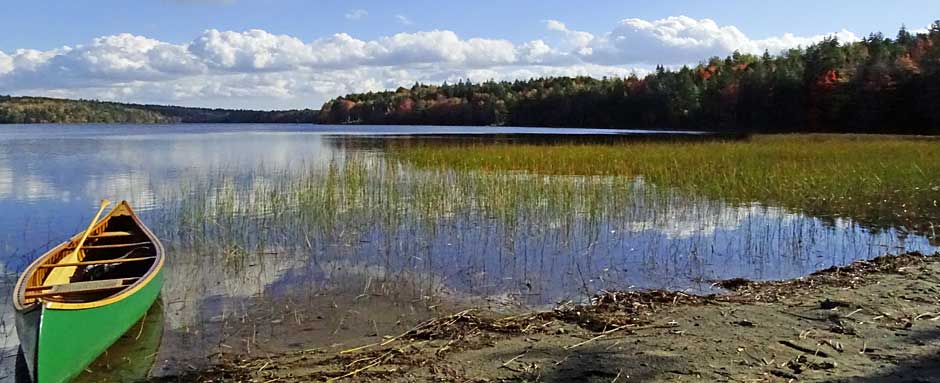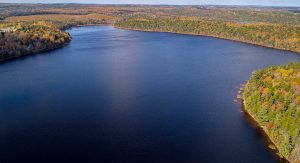
Sandy Lake (Bedford NS) View towards northwest over “northern basin”. It looks pristine, but limnological observation conducted by volunteers 2017 to 2024 and ongoing indicate it’s in a highly precarious state now, before the shovels have hit the ground for a new development that could house up to 16000 people in an area of concentration of headwaters and many wetlands. Stantec Consultants said they did not intend to ignore the observations in their Community Studies of the Sandy Lake SPA, but noted that their studies were “accepted”. Click on image for more aerial views.
By David Patriquin
SUMMARY The critical data have to do with very low deep water oxygen and evidence for “Internal Phosphorous Loading” in Sandy Lake. Recent monitoring and research reveal that such conditions now exist in more than a few lakes in HRM and elsewhere in NS. Mitigation measures additional to those now being recommended for new developments – including in some cases, no new development – are required to protect the water quality of such lakes.
A related issue: Why did Stantec Consultants “ignore” our observations? They offer no explanation. The most likely justification or pretext for excluding them that I can come up with, and which is suggested by the one reference to them in the Stantec Reports, is that they were conducted by volunteers who were seen as biased, and/or not scientifically competent. It’s an important issue because probably well more than 50% of all monitoring of surface waters in NS is conducted by volunteers. Today we call such activity “Citizen Science”. Do we dismiss it a priori or consider criteria for assessing its credibility?
UPDATES (10 Nov 2025)
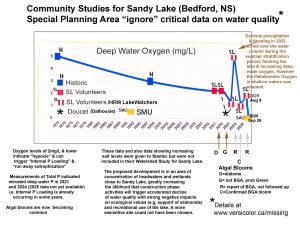 Changes in Deep Water (Hypolomnion) Oxygen during the period of maximum summer stratification 1971 to 2025. – Wed Nov 12,2025 Public Open House on Sandy Lake Special Planning Area |
ORIGINAL POST
On May 16, 2025, the Nova Scotia Government/Dept. of Growth and Development announced (bolding inserted): “Community studies are complete for two areas identified by Halifax Regional Municipality (HRM) for growth – the Sandy Lake special planning area in Bedford and the Highway 102 west corridor lands in Halifax” and that “the municipality will now undertake secondary planning for the two areas.”
From the News Release (bolding inserted):
Recommendations focused on the areas most suited for development and suggested secondary planning work in both study areas. They include:
|
In a May 16, 2025 CBC article about this announcement, Nova Scotia’s Minister of Growth and Developmen, Colton LeBlanc, is quoted as responding empathetically to environmental concerns:
“Nova Scotians take great pride in our environment and our government … would not do anything to jeopardize our environment”

Map of the Sandy Lake Study Area. Click on image to go to the Future Service Area Study Area page with links to the Stantec Community Studies for Sandy Lake.
Stantec Consulting Ltd. was awarded the contract to conduct the Future Serviced
Communities Studies for four Special Planning Areas, including Sandy Lake. In the lead-up to these studies, I shared and discussed with Stantec Consultants a large set of observations (data) pertaining to the current state of Sandy Lake obtained 2017-2024 by the “Sandy Lake Volunteers”. I also brought to their attention related observations obtained in 1971 and 2021 by other observers.
Reading Stantec’s Summary, Watershed and LSA reports for the Sandy Lake Special
Planning Area released on May 16th, I was dismayed to see that these observations were not made use of in their reports. “Shocked” might be a better description of my reaction.
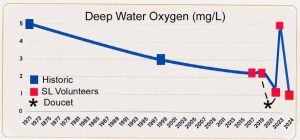
Some of the “Missing Data”: Deep Water Oxygen Levels in late summer at Sandy Lake 1971-2024. Stantec conducted sampling in 2023, a year that our observations indicate was highly anomalous, heavy rains in mid-summer essentially flushing the lake – so deep water oxygen spiked upward, but was down again the next year.
These “Missing Data” provide evidence that Sandy Lake, while classified as lower level mesotrophic* based on Total Phosphorus, is currently in a highly precarious state with very low deep water oxygen levels and occurrence of “Internal P Loading” in some years; there is also a worrisome “metalimnetic oxygen minimum” in shallower waters. The lake’s precarious state, in combination with the site of the proposed developments being in an area that can be expected to be highly sensitive to development, greatly increase the likelihood that inadvertent effects of development, particularly during the construction phase, could trigger very difficult-to-reverse declines in the water quality of Sandy Lake.
* See Note at bottom of this page for an explanation of lake trophic levels.
I asked (May 28, 2025) a senior planner at Stantec who is the individual with whom I had most communication, why the Stantec Reports did not reference any of the information that I shared with them. He responded July 15, 2025, thanking me for my input and commenting that they “did not intend to ignore your input”, and noted that the Sandy Lake work was “accepted”. He provided no explanation as to why the input was ignored.
I have written the Honourable Colton LeBlanc (Minister of Growth and Development, Nova Scotia) and Melissa Eavis (HRM, Lead Planner for the Sandy Lake SPA) describing in detail the “Missing Data” and the inadequacy of the recommended mitigative measures. I appealed to Minister LeBlanc,
“…that the missing data and related comments and concerns be appropriately considered – not that they be accepted necessarily, but that they be properly vetted e.g. by asking an independent authority to review the observations and comments and the Stantec Reports and to make recommendations accordingly.
“I would hope that the secondary planning process could be put on hold pending the outcome of such a review.
“Regardless, I bring the missing data to your attention and of Melissa Eavis, HRM Lead Planner for the Sandy Lake SPA and of others who may be involved in making decisions related to the Sandy Lake development and the secondary planning process.”
The “Missing Data Issue” has ramifications beyond Sandy Lake

A recent scientific paper explains and tests the “Anoxia Begets Anoxia” hypothesis. For A popular summary, see article in phys.org.
First is the matter of the very low deep water oxygen and evidence for IPL (Internal Phosphorus Loading) in Sandy Lake. Very low deep water oxygen levels can trigger IPL, which in turn can further reduce deep water oxygen levels, triggering a runaway eutrophication process (“anoxia begets anoxia”). Recent monitoring has indicated such conditions may now be quite common in HRM lakes and elsewhere in Nova Scotia lakes.
It’s an important issue because the strategy for protecting Water Quality of HRM lakes is one of “No Net Increase in Phosphorus Loading” or NNIP. Currently, NNIP applies only to external phosphorus loading. Clearly, to protect our lakes we need to (i) recognize where/when Internal Phosphorus Loading occurs (hence my concern about the Missing Data), and (ii) modify the monitoring and recommended mitigative measures accordingly.
Overall, HRM has been very progressive in its monitoring of our lakes and in taking science-based and common sense steps to better protect our lakes. I have no doubt that sooner or later, the issue of Internal Phosphorus Loading would be addressed. However for Sandy Lake and prob. many others, “later ” could be too late.
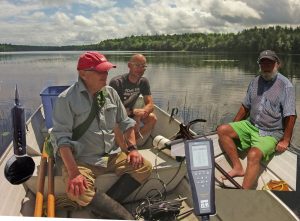
Water sampling on Sandy Lake, Aug 14, 2023, here by the outlet. Composite pic showing equipment (details here)
Click on image for larger version
Second is the issue of why our observations were ignored. The most likely justification or pretext for excluding them that I can come up with, and which is suggested by the one reference to them in the Stantec Reports, is that they were conducted by volunteers who were seen as biased, and/or not scientifically competent. It’s an important issue because probably well more than 50% of all monitoring of surface waters in NS is conducted by volunteers. Today we call such activity “Citizen Science”. Do we dismiss it a priori or consider criteria for assessing its credibility?
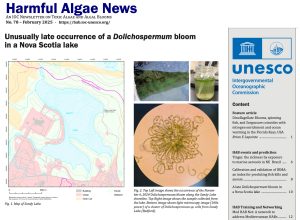
A unusually late bloom of Blue-Green Algae occurred on Sandy Lake on Nov 6, 2024. A volunteer observed the bloom and took samples that were later examined by Prof, Linda Campbell at Saint Mary’s University; the ID (Dolichospermum sp) was made by Dr. Michael Agbeti of Bio-Limno Research & Consulting. Our various volunteer observations suggested the bloom occurred when nutrient-rich deep water turned over as the lake cooled. View
– Report in Harmful Algal News
– Report on this website
The Halifax LakeWatchers program initiated in 2022 makes a lot of use of volunteers and ensures that equipment is well maintained and volunteers are well trained; so going forward at least, such volunteer observations will likely be broadly accepted as scientifically valid. But what about the historical observations? It is surely valuable info. in this era of rapid environmental change. Can criteria be applied to make some assessment of the validity of historical Citizen Science observations?
These issues are discussed in detail in documents I sent last week to NS Growth and Development Minister LeBlanc and to HRM Lead Planner for the Sandy Lake SPA Melissa Eavis; cc’d to others involved in decision-making related to the Sandy Lake SPA and/or other lakes in HRM.
View Documents Website (www.versicolor.ca/sdocs)
or go directly to these Documents (PDFs) sent July 18, 2025:
– Covering Letter
3 pages, 57 KB
– Comments Document
31 pages, 1.8 MB
– Notes
33 pages, 2.4 MB
Note on lake trophic levels
“Lakes range from an oligotrophic to a eutrophic state in a lake trophic classification system. An oligotophic lake is one that is characterized as having a high degree of water clarity, sufficient supply of oxygen at all levels and fewer conditions to promote the growth of algae and plants within the lake. The upper limit of total annual phosphorus loading for an oligotrophic state is 10μg/L. The mesotrophic state is the transitional stage between oligotrophic and eutrophic on the continuum. A mesotrophic lake has an
accumulation of sediments, a higher concentration of phosphorus and algae (often measured as chlorophyll), and some loss of oxygen at the lower levels of the lake. The range of total annual phosphorus loading for a mesotrophic state is 10 – 20μg/L. A eutrophic lake contains high concentrations of phosphorus and algae (chlorophyll) and is rich with plant nutrients. A eutrophic lake is characterized by poor water clarity, little or no oxygen at lower depths, an abundance of plants and the emergence of algae blooms. A lake is considered to be in a eutrophic state when total annual phosphorus exceeds 20μg L. The process of eutrophication is naturally occurring and typically takes thousands of years to complete. In a developed watershed, a lake can become eutrophic in a few decades. One of the key contributors to an accelerated rate of eutrophication, known as cultural eutrophication, is the abundant release of phosphorus to receiving waterbodies…” From HRM Municipal Planning Strategy for Planning Districts 14/17 posted at https://www.halifax.ca/media/83903
Short URL to reach this page: www.versicolor.ca/missing
